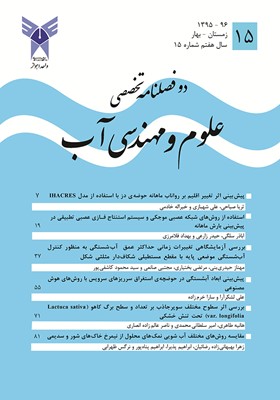Prediction of scour dimension in the Plunge Pools below Outlet Bucket with Artificial intelligence method
الموضوعات :علی لشکرآرا 1 , سارا خرم زاده 2
1 - دانشجوی دکتری، گروه مهندسی منابع آب، واحد شوشتر، دانشگاه آزاد اسلامی، شوشتر، ایران.
2 - دانش آموخته کارشناسی ارشد، گروه سازه های آبی، پردیس علوم و تحقیقات واحد خوزستان، دانشگاه آزاد اسلامی، اهواز، ایران.
الکلمات المفتاحية: Optimization, Artificial Neural Network, Scour, Adaptive neuro-fuzzy inference system, بهینه یابی, آبشستگی, Outlet Bucket, سرریزهای جامی شکل, شبکه عصبی مصنوعی و سیستم تطبیقی عصبی &ndash, فازی,
ملخص المقالة :
Accurate prediction of sediment scour hole dimensions downstream of hydraulic structures, e.g. the outlet bucket, is a complex and not straight forward engineering problem encountered worldwide. Because of the complexities of the study, its comprehensive, simultaneous including water flow, sediment and applying all of the effective variables involved in scouring it is not easy possible. Dimensions of a scour hole are usually determined by empirical equations which their validation is limited by experimental conditions. As constructing physical models has its own difficulty, determining of scour hole parameters has been applied in this paper for a collection of previous experimental studies. Two artificial intelligence techniques (ANN & ANFIS) are used and the results are compared with empirical equation for maximum scour holes using nonlinear regression method. Artificial Neural Network (ANN) simply represents interconnection of neurons, each of which carries out the task of combining the input, determining its strength by comparing the combination and finding out the result. On the other hand, ANFIS is a hybrid scheme which uses the learning capability of the ANN to derive the fuzzy rules with membership functions. The results showed that maximum error caused by applying ANFIS techniques in estimating scour hole dimensions was 5.2 percent while the error in neural network model was 10.38 percent. The significance of different parameters was discussed and a simple, innovative formula was proposed. This formula is an interesting tool for the engineering community due to its preferences for estimating the parameters of complex phenomena like erosion procedures. It has been established that scour estimations could be improved if soft computation is used in place of the traditional formulae.
اسدی سریزدی، م.ح. قدسیان، م. (1377). تعیین اثر شعاع جام پرتابی ساده در عمق آبشستگی پایین دست سرریزها. پایان نامه کارشناسی ارشد، دانشگاه تربیت مدرس.
اسدیانی یکتا، ا. سلطانی، ف. (1385). مقایسه کاربرد شبکه تطبیقی عصبی-فازی با شبکه عصبی مصنوعی در پیشبینی جریان رودخانه زاینده رود. هفتمین سمینار مهندسی رودخانه، دانشگاه شهید چمران اهواز.
تاج کریمی، د. قدسیان، م. (1383). تحلیل آبشستگی بستر ناشی از جت های ریزشی و کاربرد شبکه عصبی مصنوعی در آن. پایان نامه کارشناسی ارشد، دانشگاه تربیت مدرس.
طارقیان، ر. کاشفی پور، س.م. (1385). پیشبینی سطح آب در مخزن با استفاده از سیستم استنتاج فازی-عصبی تطبیقی. هفتمین سمینار بین المللی مهندسی رودخانه، دانشگاه شهید چمران اهواز.
منتظر، م. قدسیان،م. (2002). ارائه روشی هوشمند به منظور برآورد حداکثر عمق آبشستگی دماغه آبشکنها با استفاده از شبکه عصبی مصنوعی. ششمین سمینار مهندسی رودخانه، دانشگاه شهید چمران اهواز.
نصیری صالح، ف. منتظر، غ. (1380). تعیین ابعاد حفره آبشستگی پایین دست سرریزهای ریزشی آزاد با استفاده از روش شبکه عصبی مصنوعی. سومین کنفرانس هیدرولیک ایران، دانشکده فنی دانشگاه تهران.
Azmathullah, H. MD., and Deo, M.N, Deolalikar, PB, (2005). Neural Networks for estimation of scour downstream of a Ski-Jump bucket. Journal of Hydraulic Engineering. ASCE,131,10, pp: 898-908
Bateni, S. M., and Borghei, S.M. and Jeng, D. S. (2007). Neural network and neuro-fuzzy assessments for scour depth around bridge piers. Engineering Applications of Artificial Intelligence, pp: 401-414.
Borman N. E., and Julien, P. Y. (1991). Scour downstream of grade-control structure. J. Hydraul. Eng., 117, 5, pp: 579-594.
Breusers, H. N. C. and A. J. Raudkivi. (1991). Scouring. Hydraulic structure design manual, No 2 IAHR. Balkema. 143p.
U.S. Bureau of Reclamation. (1965). Design of Small Dams.
Grishin, M. M. (1982). Hydraulic Structures, Mir Publisher, Moscow, Vol. 1,2.
Jang, J. S. R. (1993). ANFIS: Adaptive Network based Fuzzy Interface System. IEEE Trans., Man and cybernetics, 22, 3, pp: 665-685.
Lippmann, R. P. (1987). An Introduction to Computing with Neural Nets.IEEE ASSP Magazine, pp: 4-22.
Robinson, K. M., Hanson, G. J., and Cooke, K. R., (1998). Velocity field measurements at an overfall, American Society of Agricultural Engineering., No.982063.
Rouse, H., (1940). Criteria for Similarity in the transportation of sediment. Studies in Engineering Bullentin. University of IWA, 20, pp: 33-49.
Trent, R., Gagarin, N., and Rhodes, J. (1993). Estimating pier scour with artificial neural networks.Proc., Hydraulic Engineering 1993, ASCE, New York, pp: 1043-1048.


